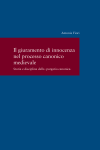Il giuramento di innocenza nel processo canonico medievale
Storia e disciplina della "purgatio canonica"
Zusammenfassung
The oath of innocence, or purgation, constituted a part of canon law for almost a millennium. It has nevertheless been largely neglected by studies on medieval canonical procedure. This book seeks to reconstruct the history of the oath of purgation specifically from the perspective of canon law. Over the centuries, the function of the so-called "purgatio canonica" never changed: priests of the Church were required to swear their innocence when charged with any criminal offence for which evidence of guilt was lacking. It is while dealing with the canonical purgation that the canonists also developed the notion of infamia facti, a concept of social disrepute with real legal significance. Within a short space of time this inspired the most significant innovations in medieval legal procedure: the introduction of the inquisitorial process alongside the accusatorial model, the elaboration of a canonical theory of legal presumptions, and the justification of judicial torture. The history of the oath of purgation thus provides a unique perspective from which to observe the transformations which occurred in canon law procedure and wider legal culture throughout the course of the Middle Ages.
Ricapitolazione
The oath of innocence, or purgation, constituted a part of canon law for almost a millennium. It has nevertheless been largely neglected by studies on medieval canonical procedure. This book seeks to reconstruct the history of the oath of purgation specifically from the perspective of canon law. Over the centuries, the function of the so-called "purgatio canonica" never changed: priests of the Church were required to swear their innocence when charged with any criminal offence for which evidence of guilt was lacking. It is while dealing with the canonical purgation that the canonists also developed the notion of infamia facti, a concept of social disrepute with real legal significance. Within a short space of time this inspired the most significant innovations in medieval legal procedure: the introduction of the inquisitorial process alongside the accusatorial model, the elaboration of a canonical theory of legal presumptions, and the justification of judicial torture. The history of the oath of purgation thus provides a unique perspective from which to observe the transformations which occurred in canon law procedure and wider legal culture throughout the course of the Middle Ages.
Schlagworte
Prozess Kanonisches Recht Kirche Mittelalter Priester Rechtsgeschichte Rechtsprechung- XVII–XX Premessa XVII–XX
- 1–26 Introduzione 1–26
- 341–372 Cap. XI: I compurgatores 341–372
- 581–584 Conclusioni 581–584
- 585–618 Bibliografia 585–618
- 629–630 Indice dei manoscritti 629–630

